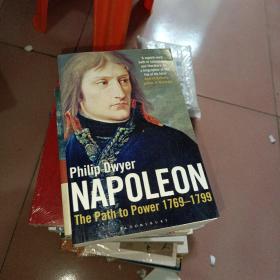
拿破仑传 权利之路 英文原版书 Napoleon The Path to Power 卷一 法国军事家拿破仑 英文版人物传记 进口书籍正版
0747566771
¥ 199.6 九五品
库存5件
作者Philip Dwyer
出版社Bloomsbury Publishing PLC
ISBN9780747566779
出版时间2008-01
装帧平装
开本32开
页数672页
货号579892803488
上书时间2023-11-19
- 在售商品 暂无
- 平均发货时间 43小时
- 好评率 暂无
- 最新上架
商品详情
- 品相描述:九五品
- 商品描述
-
书名:Napoleon: The Path to Power拿破仑传:权利之路
作者:Philip Dwyer
出版社名称:Bloomsbury Publishing PLC
出版时间:2008
语种:英文
ISBN:9780747566779
商品尺寸:12.9 x 4 x 19.8 cm
包装:平装
页数:672
拿破仑·波拿巴,即拿破仑一世,是十九世纪法国伟大的军事家、政治家,也是法兰西第1帝国的缔造者。他有着杰出的军事指挥才能,但其执政之路并非一帆风顺。拿破仑雄心勃勃,又善于将各种军事策略运用到实战之中,30岁就成为法国第1执政,一生缔造了无数传奇。本书Napoleon: The Path to Power 1769 - 1799 v. 1《拿破仑传:权利之路(卷一)》深入探究了拿破仑的成长历程、性格及其早年的伟大成就,让读者对于拿破仑的少年和青年时期有更加全面的了解。
Napoleon Bonaparte's rise to power was neither inevitable nor smooth; it was full of mistakes, wrong turns and pitfalls. During his formative years his identity was constantly shifting, his character ambiguous and his intentions often ill-defined. He was, however, highly ambitious, and it was this ruthless drive that advanced his career. This book examines the extraordinary evolution of Napoleon's character and the means by which at the age of thirty he became head of the most powerful country in Europe and skilfully fashioned the image of himself that laid the foundation of the legend that endures to this day.
Review
'This life of his hero in two volumes is the work that Dwyer was placed on earth to write ... We are clearly in the presence of what will be a monumental work ... meticulously researched and well-written first volume, which leaves the reader keenly anticipating the second'
--Andrew Roberts, Literary Review
'Remarkable ... a satisfying, psychologically convincing account of Napoleon's early years and ascent to power. Even-handed and authoritative, this fascinating and highly enjoyable book will be an eye opener even to those who think they know the subject well'
--Adam Zamoyski, Sunday Times
'Bonaparte's staggering ambition and penchant for blaming others for his mistakes are apparent throughout' --Financial Times Summer Books
'An extraordinary story ... Dwyer has his own way of telling the story and this makes his book more than just a canter across familiar terrain ... an attractive addition to the literature on one of the most controversial figures in modern European history'
--Thomas Munch-Petersen, BBC History Magazine
Philip Dwyerstudied in Perth (Australia), Berlin and Paris, where he was a student of France's pre-eminent Napoleonic scholar, Jean Tulard. He has published widely on the Revolutionary and Napoleonic eras, and is the editor of Napoleon and Europe, the author of Talleyrand, and has co-edited Napoleon and His Empire: Europe, 1804-1814. He is currently Senior Lecturer in Modern European History at the University of Newcastle, Australia, and is working on the second volume of his biography of Napoleon. Napoleon:The Path to Power, 1769-1799 has also been shortlisted for The Prime Minister's Literary Awards.
The Outsider, 1769-1792
The Revolutionary, 1792-1796
The Conquering Hero, 1796-1798
The Civilizing Hero, 1798-1799
Seizing Power, 1799
Napoleon is one of those figures whose legend is so persistent that it often confounds historical reality, especially in the popular imagination. Indeed, Napoleon contributed much towards constructing his own myth, from his youth even until after he fell from power, when, while in exile, he dictated his memoirs to a group of disciples who took down his every word in the hope that his version of history would prevail. Such were Napoleon’s skills as a chronicler that much of the legend is still unquestioningly accepted.
One of the most blatant examples of the legend of Napoleon prevailing is in the account we have of the battle to take Arcola, a nondescript northern Italian village in a desolate setting about thirty-two kilometres east of Verona. On a bleak winter’s day in November 1796, French and Austrian imperial forces confronted each other, separated by the river Alpone and a small wooden bridge that was about thirty paces long and set on three stone piles. The unimposing bridge, still in its original place, is now made of concrete and metal. The road leading up to it is built up above the surrounding fields; there is a dyke on either side of the road, and also on either side of the river bank, in order to prevent the village and the surrounding fields from flooding. Crossing this bridge at the earliest possible moment was crucial to Bonaparte’s plan.
On the opposite side of the Alpone facing the French were two battalions of Croatians, part of the Austrian imperial army, and several cannon placed in such a way that they could fire on anyone approaching the bridge along the exposed roadway for hundreds of metres. Rather than advance, the French troops took cover behind the dykes. Some of Bonaparte’s leading generals — Lannes, Bon, Verdier and Verne — were wounded trying to lead their men forward. ‘At that disheartening sight, [General Pierre-François] Augereau [who would go on to become a marshal of the Empire], the intrepid Augereau, rushed forward, went through the ranks of frightened soldiers, tore the flag from the flag bearer and advanced towards the enemy; a courageous few followed him, the others hesitated; but vile shots having killed five or six, they retreated and again took refuge behind the embankment.” Augereau, although abandoned by his men, escaped without injury and returned to his starting point.
1234567'
相关推荐
-

拿破仑传权利之路
九五品北京
¥ 50.00
-
![拿破仑传 9787514236682 /[英]](https://www0.kfzimg.com/sw/kfz-cos/kfzimg/4390585/68c5a525e4eee859_s.jpg)
拿破仑传 9787514236682 /[英]
全新开封
¥ 103.12
-

拿破仑(英)(人物传纪)
八五品北京
¥ 7.00
-

权利之路(林登约翰逊传)
九品西安
¥ 260.00
-

权利之路 林登 约翰逊传
九品青岛
¥ 268.00
-

正版图书|拿破仑传英笛福
九品东莞
¥ 3.30
-

通往权利之路 撒切尔夫人之传
八五品长沙
¥ 11.91
-

拿破仑传 卷一:权利之路 英文原版 Napoleon: The Path to Power 1769 - 1799 v. 1
九品
¥ 100.00
-

拿破仑传 卷一:权利之路 英文原版 Napoleon: The Path to Power 1769 - 1799 v. 1
九五品广州
¥ 126.00
-

拿破仑传 9787514236682 (英)约翰·霍兰罗斯
全新南京
¥ 104.30
— 没有更多了 —















以下为对购买帮助不大的评价